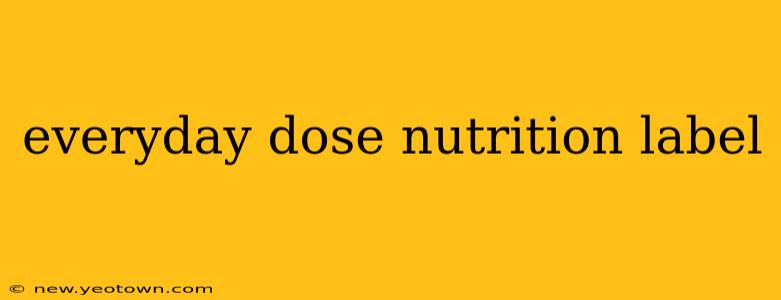Let's be honest, staring at a nutrition label can feel like deciphering hieroglyphics. Those tiny numbers and often confusing terms can leave even the most health-conscious among us scratching our heads. But understanding your daily dose, as represented on the nutrition label, is crucial for making informed choices about the food you eat and maintaining a healthy lifestyle. This isn't just about counting calories; it's about understanding the quality of those calories and the nutrients they provide. Imagine yourself, armed with this knowledge, confidently navigating the grocery aisles, making choices that truly nourish your body. Let's embark on this journey together.
What Information is on a Nutrition Label?
The nutrition facts panel, that rectangular box on the back or side of most packaged foods, is your roadmap to understanding the nutritional content. It's a standardized format, mandated by regulatory bodies, ensuring consistency across different brands. But it's not just a list of numbers; it's a story about the food you're about to consume.
Think of it as a snapshot of the food's composition, broken down into key components:
-
Serving Size: This is the crucial starting point. All the values listed are based on this serving size. Pay close attention – a serving size might be smaller than you expect.
-
Calories: The total energy provided by the food in a single serving. This is a good starting point for overall energy intake management.
-
Macronutrients: These are the big players:
- Total Fat: The total amount of fat in grams. Pay attention to the breakdown into saturated and trans fats, as these can negatively impact heart health.
- Cholesterol: Found mostly in animal products. High cholesterol levels can be a risk factor for heart disease.
- Sodium: Essential for bodily functions, but excessive sodium intake can contribute to high blood pressure.
- Total Carbohydrate: The total grams of carbohydrates, broken down into:
- Dietary Fiber: Important for digestive health.
- Total Sugars: Includes naturally occurring sugars and added sugars. Limit added sugars for optimal health.
- Protein: Essential for building and repairing tissues.
-
Micronutrients: Vitamins and minerals, usually listed in percentages of the recommended daily intake (%DV).
How to Interpret the Information Effectively?
Now that we understand the components, let's tackle how to interpret them effectively. This is where the true power of the nutrition label unfolds.
What are the Daily Values (%DV)?
The %DV is the percentage of the recommended daily intake of a nutrient based on a 2,000-calorie diet. This provides context to the numbers, enabling you to see at a glance whether a food is high or low in a particular nutrient. For example, a food with 20% DV of Vitamin C means that one serving provides 20% of the recommended daily intake of Vitamin C. Keep in mind that 2,000 calories is an average, and your individual needs might differ.
How Can I Use This Information to Make Healthier Choices?
The nutrition label empowers you to compare similar products. Are you choosing between two different brands of yogurt? The nutrition label allows you to compare sugar content, fat content, and other crucial factors to make the most nutritious choice.
What About "Added Sugars"?
This is a relatively new addition to nutrition labels and is extremely important. Added sugars are sugars that manufacturers add to foods during processing. These are often empty calories, offering little nutritional value beyond sweetness. Aim to minimize your added sugar intake.
What is the Difference Between Naturally Occurring and Added Sugars?
Naturally occurring sugars are found naturally in foods like fruits and dairy products. While still sugars, these are often accompanied by vitamins, minerals, and fiber, making them a healthier choice than refined added sugars.
How Can I Use Nutrition Labels to Manage My Calorie Intake?
Using the calorie information along with the serving size, you can better track your daily calorie consumption to achieve your weight management goals. Remember, calorie needs vary based on age, activity level, and individual metabolism.
By mastering the art of reading nutrition labels, you empower yourself to make informed decisions about your diet, promoting a healthier and happier you. Remember, the label is a tool, and understanding it is the key to unlocking a more nutritious life.

